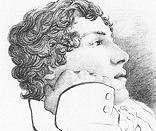"La Belle Dame Sans Merci" translates to 'the beautiful woman has no mercy'. This is not the first time in Keats's poetry that we have heard this phrase- he also used it in "The Eve of St Agnes", another romantic poem rich "negative capability". It is as if these syllables have continued to haunt him; he has expressed this questioning in "La Belle Dame Sans Merci" by presenting us with the set for a story, but no conclusion or closure. Initially this ballad looks quite simplistic, the structure of the poem being a ballad looks very different from Keats other poems, and the reader can be fooled into believing its like a rhyme; not taking the content seriously. However the structure is effective in creating a haunting atmosphere. The short stanzas give an abrupt feeling to the poem, and the fourth shorter line ending the stanza gives a rapid but unfulfilled closure to that section.
Keats uses the most common form of ballad I think to emphasis the impact of the content of the poem. The story of is of a treacherous woman who tempts men away from the real world and then leaves them- their dreams unfulfilled and their lives blighted. A haunting ominous effect is created throughout Keats's use of formal features of a traditional ballad. Keats uses the traditional features of a ballad, such as repetition of words and phrases, as well a quatrain rhyming scheme and four line stanza. However Keats alters the traditional ballad by shortening the last line of each stanza; with fewer stresses. The repetition was used to aid the memory in conventional ballads, however Keats uses it to enhance the haunting effect, creating a feeling of the word being echoed for the reader. The shorter last...


